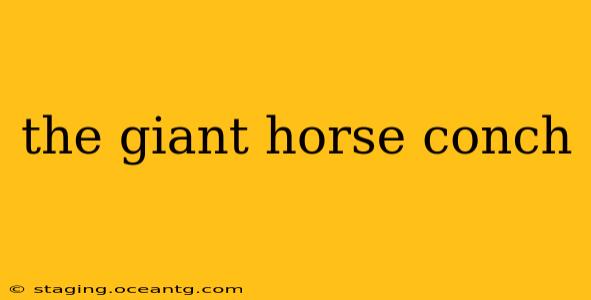The giant horse conch ( Triplofusus giganteus) is a truly magnificent creature, a testament to the beauty and diversity of the marine world. This large sea snail, a gastropod mollusk, commands attention with its impressive size and striking appearance. Its presence in its natural habitat is a sight to behold, and understanding its biology, habitat, and conservation status is crucial for its continued survival.
What is a Giant Horse Conch?
The giant horse conch is easily identifiable by its massive, robust shell, which can reach lengths of up to 24 inches (60 cm). The shell's spiral is impressive, with distinct whorls that grow larger towards the aperture (opening). The exterior is typically a creamy white or light beige, often adorned with intricate, brown spiral bands. The shell's surface is relatively smooth compared to other conch species, giving it a polished, almost elegant look. Unlike many other snails, the giant horse conch's shell doesn't have prominent spines or knobs. The aperture (opening) is large and oval-shaped.
Where Do Giant Horse Conches Live?
Giant horse conches are found in the western Atlantic Ocean. Their range extends from the southern United States (Florida) down through the Caribbean Sea and into parts of the Gulf of Mexico. They inhabit shallow, sandy or seagrass habitats, typically in waters less than 100 feet deep. They prefer areas with ample food sources and relatively calm waters.
What is the habitat of a giant horse conch?
Giant horse conches are benthic organisms, meaning they live on or near the ocean floor. They favor habitats with soft substrates like sand or mud, often in close proximity to seagrass beds. These beds provide them with both protection and a rich food source. The specific habitat requirements highlight the importance of maintaining healthy coastal ecosystems to ensure their survival.
What Do Giant Horse Conches Eat?
Giant horse conches are carnivorous predators. Their diet primarily consists of other mollusks, particularly smaller snails and clams. They use their strong radula (a tongue-like structure with teeth) to bore into the shells of their prey and consume the soft tissues within. Their predatory behavior plays a significant role in the balance of their respective ecosystems.
What are the predators of giant horse conches?
While adult giant horse conches have few natural predators due to their large size and strong shell, smaller juveniles are vulnerable to various marine animals including larger fish and crustaceans. Certain species of sharks and rays may also prey upon them.
Are Giant Horse Conches Endangered?
Giant horse conches are currently listed as a species of "least concern" by the IUCN. However, their populations have been impacted by human activities, primarily over-collection for the shell trade and habitat destruction. Sustainable harvesting practices and marine conservation efforts are vital to ensure the long-term survival of this magnificent species.
What are the threats to giant horse conches?
The primary threats are habitat loss due to coastal development, pollution, and over-collection for the shell trade and aquarium industry. These factors significantly impact their populations and emphasize the need for strict regulations and conservation strategies.
How can I help protect giant horse conches?
Supporting responsible fisheries, reducing your environmental impact, and advocating for marine conservation efforts are all crucial in protecting giant horse conches and their habitats. Raising awareness about the importance of protecting this species and its ecosystem is also vital.
Conclusion
The giant horse conch is a remarkable marine creature, a symbol of the ocean's immense biodiversity. Understanding its ecology, threats, and conservation needs is essential to ensuring its continued presence in our oceans for generations to come. By appreciating the beauty and importance of this magnificent mollusk, we can collectively contribute to its protection and the preservation of its delicate marine habitat.
